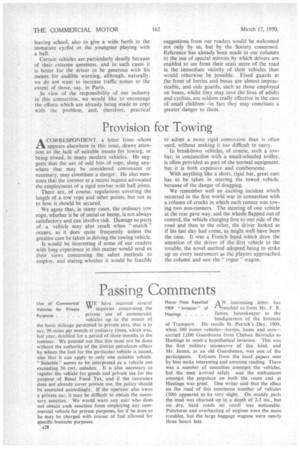Provision for Towing
Page 30

If you've noticed an error in this article please click here to report it so we can fix it.
ACORRESPONDENT. a letter from whom appears elsewhere in this issue, draws attention to the lack of suitable means for towing, or being towed, in many modern vehicles. He suggests that the use of odd bits of rope, slung anywhere that may be considered convenient or necessary, may constitute a danger. He also mentions that the coroner at a recent inquest advocated the employment of a rigid towbar with ball joints.
There are, of course, regulations covering the length of a tow rope and other points, but not as to how it should be secured.
We agree that, in many cases, the ordinary tow rope, whether it be of metal or hemp, is not always satisfactory and can involve risk. Damage to parts of a vehicle may also result when " snatch " occurs. as it does quite frequently unless the greatest care be taken in driving the towing vehicle. It would be interesting if some of our readers with long experience in this matter would send us their views concerning the safest methods to employ, and stating whether it would be feasible to adopt a more rigid connection than is often used, without making it too difficult to carry.
In breakdown vehicles, of course, such a towbar, in conjunction with a stnall-wheeled trolley, is often provided as part of the normal equipment, but it is both expensive and cumbersome.
With anything like a short, rigid bar, great care has to be taken in steering the towed vehicle. because of the danger of dragging.
We remember well an exciting incident which occurred in the first world war in connection with a column of crocks in which each runner was towing two non-runners. The steering of one vehicle at the rear gave way, and the wheels flapped out of control, the vehicle charging first to one side of the road and then to the other, the driver looked as if his last day had come, as might well have been the case. It was a French band which drew the attention of the driver of the first vehicle to the trouble, the novel method adopted being to strike up on every instrument as the players approached the column and saw the " rogue " wagon.




























































































